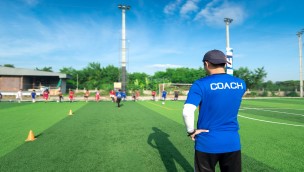Back pain
Back pain is very common in athletes and the general population. The pain can come in a variety of forms, but it’s rarely serious.

Around 85% of people will, at one point or another, experience back pain. Almost all of these people will recover within three months. Approximately half will relapse, while a small number will end up with persistent pain. Back pain is common in sports such as cross-country skiing, rowing, and tennis, and it often affects an athlete’s ability to perform.
Causes
98% of acute back pain lack a clear-cut cause. They can sometimes occur as the result of one specific event, for example from a sprain, kick or fall, while other times the cause is unknown.
Having a lot of pain doesn’t necessarily mean that the injury is severe, and two athletes can experience the pain differently. One of the reasons for this is that many factors influence back pain, amongst others the level of activity, sleep, mood, thoughts, feelings, stress levels, past experiences with injuries, as well as how one handles the pain. Alltogether, these factors create different conditions for how the pain is experienced.
The nervous system’s ability to regulate pain
Our nervous system can regulate how much pain we feel. Observations have shown that the nervous system sometimes becomes over-sensitised in people with persistent pain conditions. This means that it is possible to feel pain even after the tissues have completely healed.
Signs and symptoms
The main symptom is pain that is aggravated with movements involving the back. It is not uncommon for pain to spread down into the thighs and buttocks. This can happen without nerve injury.
Contact a doctor
If you are in constant pain, even when resting. Also, if you: experience fever, weight loss, a drastic reduction in strength, if you lose sensation high up on the inside of your thighs, or if you lose control of your bladder or bowels.
Diagnosis
A systematic clinical examination by a doctor or physiotherapist will help to rule out any serious diseases. Only 1-2% of back pain cases have an underlying cause that is serious.
Research shows that age-related changes in the back are completely normal. This means that MRI and X-ray scans can also show «injuries» in those who are symptom-free. Any findings should, therefore, be interpreted with caution. The patient should not be referred to MRI or X-rays too early (before 6 weeks) unless there is clear suspicion of a serious illness or injury.
Treatment
With sudden acute back pain, it might be a good idea to do a little less of painful activities in the first few days. Like you would with an acute ankle sprain. Immediately following this, it is important to resume normal activities for a speedy recovery. It is completely normal to experience a small amount of pain during activity in the beginning. Once a serious illness or injury has been ruled out, it is important to have a plan on how to return to your desired activity level. Contact your physiotherapist if you are in any doubt as to how much activity you can tolerate.
Treatments, such as massage, mobilisations and manipulations can give temporary pain relief but seldom have any long term effect. A doctor, physiotherapist, or in some cases a psychologist, can help you to understand the condition and subsequent pain.
Research has shown that there are no specific exercises or types of exercise that are ‘the best’ when it comes to treatment of lower back pain. But training in itself can provide pain relief as exercise causes the body to release hormones that act as pain killers. Choose an activity you enjoy and which doesn’t significantly aggravate the pain. Start slowly and gradually increase. Activities can be running, cycling, swimming or general strength training. It might be an idea to plan training in consultation with a physiotherapist.
Surgery is rarely recommended. Pain relief medications can help with acute pain, but prolonged use can cause negative side-effects. Therefore, it is important to consult your doctor if long-term pain relief is required.


